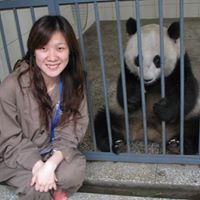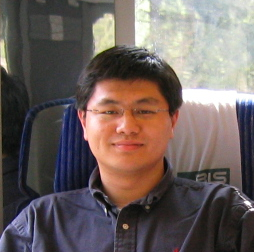Zhuo Chen
age ~38
from Salt Lake City, UT
Zhuo Chen Phones & Addresses
- 429 University Vlg, Salt Lake Cty, UT 84108
- Salt Lake City, UT
- Atlanta, GA
Education
-
School / High School:Harvard Law School
Ranks
-
Licence:New York - Currently registered
-
Date:2008
Lawyers & Attorneys

Zhuo Chen - Lawyer
view sourceAddress:
Yingli Green Energy
Licenses:
New York - Currently registered 2008
Education:
Harvard Law School
Us Patents
-
Air Vehicle Having Rotor/Scissors Wing
view source -
US Patent:6669137, Dec 30, 2003
-
Filed:Aug 26, 2002
-
Appl. No.:10/227955
-
Inventors:Zhuo Chen - Norcross GA 30093
-
International Classification:B64C 2724
-
US Classification:244 7R
-
Abstract:An air vehicle, such as a manned or unmanned air vehicle, has a fuselage, a rotor/scissors wing, and a scissors wing. At helicopter mode, the rotor/scissors wing rotates to make the air vehicle fly like a helicopter to achieve vertical and/or short take-off and landing, hovering, and low speed flying. At airplane mode, the rotor/scissors wing and scissors wing form a scissors wings configuration to maximize the air vehicles flying efficiency at a wide range of speed and flying conditions by adjusting the yaw angle of the rotor/scissors wing and scissors wing. During the conversion from helicopter mode to airplane mode, the scissors wing generates lift to offload the rotating rotor/scissors wing and eventually the offloaded rotor/scissors wings rotating speed is slowed and stopped so that the rotor/scissors wing can be locked at a specific position and the conversion can be achieved. In a reverse order, the air vehicle can convert from airplane mode to helicopter mode. Either turbofan or turbojet engine, or turboshaft/turbofan convertible engine can be used to power the air vehicle.
-
Spacecraft And Aerospace Plane Having Scissors Wings
view source -
US Patent:6745979, Jun 8, 2004
-
Filed:Oct 22, 2002
-
Appl. No.:10/277687
-
Inventors:Zhuo Chen - Norcross GA 30093
-
International Classification:B64C 338
-
US Classification:244 46, 244 45 R, 244 49, 244119
-
Abstract:A spacecraft such as a fly back booster or a reusable launch vehicle, or an aerospace plane has a fuselage and a set of scissors wings consisting of two main wings. Both of the main wings are rotatably mounted on the fuselage and can be yawed at opposite directions. If the spacecraft is launched vertically, both of its main wings can be yawed to be generally parallel with its fuselage so that it can connect with other vehicle or vehicles to form different launch configurations. When the spacecraft or aerospace plane is flying in the air, landing, or taking off horizontally, it can yaw both of its main wings in opposite directions to maximize its lift-to-drag ratio by optimizing the yaw angle of the main wings according to flying conditions. It can also produce desired aerodynamic characteristics such as forming a high drag configuration by adjusting the yaw angle of its main wings. The scissors wings can be used on a spacecraft that is launched vertically on the ground, or a spacecraft that is carried to the air and launched in the mid-air, or a spacecraft that takes off horizontally like an aircraft or glider.
-
Hybrid Flying Wing
view source -
US Patent:6860449, Mar 1, 2005
-
Filed:Jul 16, 2002
-
Appl. No.:10/197358
-
Inventors:Zhuo Chen - Stockbridge GA, US
-
International Classification:B64C029/00
-
US Classification:244 121, 244 5, 244 26, 244 6, 244 124, 244 126
-
Abstract:An aircraft has a flying wing and two wingtip hulls installed on the wingtips of the flying wing. Both of the wingtip hulls contain lighter-than-air gas to generate static lift. These wingtip hulls not only contribute to lift-generating but also help the aircraft achieve roll stability and control. Forward propulsion systems are installed at the upper-front positions of the flying wing. When vertical and/or short take-off and landing (V/STOL) capability is required, one or more lift-fan propulsion systems can be installed on the flying wing. The lift-fan propulsion systems can either be driven by their own engines or by the power transmitted from the forward propulsion systems. Payload can be carried inside the flying wing or be hung under or held above the flying wing.
-
Air Vehicle Having Scissors Wings
view source -
US Patent:6601795, Aug 5, 2003
-
Filed:Aug 23, 2002
-
Appl. No.:10/227130
-
Inventors:Zhuo Chen - Norcross GA 30093
-
International Classification:B64C 338
-
US Classification:244 46, 244 39
-
Abstract:An air vehicle, such as an aircraft, an unmanned air vehicle, a missile, or an aero bomb that has a fuselage and two main wings each of which has a left side wing and a right side wing. Both of the main wings are rotatably mounted on the fuselage via one or two pivots or hollow turrets so that both of them can be yawed during flight to optimize flying efficiency under various flying conditions.
Resumes

Investment Management Tax Internship
view sourceLocation:
10 Asheworth Ct northwest, Atlanta, GA 30327
Industry:
Accounting
Work:
Pwc
Investment Management Tax Internship
Ayco, A Goldman Sachs Company Jul 2014 - Dec 2014
Audit Internship
Ayco, A Goldman Sachs Company Dec 2013 - May 2014
Tax Internship
Investment Management Tax Internship
Ayco, A Goldman Sachs Company Jul 2014 - Dec 2014
Audit Internship
Ayco, A Goldman Sachs Company Dec 2013 - May 2014
Tax Internship
Education:
University at Albany, Suny 2011 - 2014
Bachelors, Bachelor of Science, Accounting
Bachelors, Bachelor of Science, Accounting

Associate Professor
view sourceLocation:
485 Lancashire Dr, Marietta, GA
Industry:
Higher Education
Work:
Centre For Health Economics Nottingham China Health Institute
Co Director
University of Georgia
Associate Professor
Cfo Leasing, Inc. Jun 2017 - Jul 2017
Statistician
The University of Nottingham Ningbo China Jun 2017 - Jul 2017
Li Dak Sum Chair Professor In Health Economics
Centers For Disease Control and Prevention Feb 2012 - Aug 2015
Senior Economist, Senior Service Fellow
Co Director
University of Georgia
Associate Professor
Cfo Leasing, Inc. Jun 2017 - Jul 2017
Statistician
The University of Nottingham Ningbo China Jun 2017 - Jul 2017
Li Dak Sum Chair Professor In Health Economics
Centers For Disease Control and Prevention Feb 2012 - Aug 2015
Senior Economist, Senior Service Fellow
Education:
Iowa State University 1999 - 2004
Master of Science, Doctorates, Masters, Doctor of Philosophy, Economics, Statistics University of Science and Technology of China 1991 - 1999
Master of Science, Masters, Bachelors, Bachelor of Science, Management, Management Science Longhe Middle School
Master of Science, Doctorates, Masters, Doctor of Philosophy, Economics, Statistics University of Science and Technology of China 1991 - 1999
Master of Science, Masters, Bachelors, Bachelor of Science, Management, Management Science Longhe Middle School
Skills:
Statistics
Stata
Data Analysis
Econometrics
Policy Analysis
Public Health
Research
Health Economics
Economics
Global Health
Qualitative Research
Health Policy
Sas
Analysis
Public Policy
Epidemiology
Program Evaluation
Health Services Research
Statistical Modeling
Quantitative Analytics
Time Series Analysis
R
Biostatistics
Data Mining
Quantitative Research
Economic Research
Logistic Regression
Data Collection
Research Design
Survey Research
Sas Programming
Development Economics
Applied Econometrics
Survey Design
Linear Regression
Predictive Modeling
Economic Forecasting
Stata
Data Analysis
Econometrics
Policy Analysis
Public Health
Research
Health Economics
Economics
Global Health
Qualitative Research
Health Policy
Sas
Analysis
Public Policy
Epidemiology
Program Evaluation
Health Services Research
Statistical Modeling
Quantitative Analytics
Time Series Analysis
R
Biostatistics
Data Mining
Quantitative Research
Economic Research
Logistic Regression
Data Collection
Research Design
Survey Research
Sas Programming
Development Economics
Applied Econometrics
Survey Design
Linear Regression
Predictive Modeling
Economic Forecasting
Interests:
Jogging
Badminton
Reading
Badminton
Reading
Languages:
English
Mandarin
Mandarin
Certifications:
Publons
Verified Peer Reviewer
Verified Peer Reviewer

Zhuo Chen
view source
Zhuo Chen
view sourceYoutube
Myspace
Plaxo

Zhuo Kuan Chen
view sourceya at Development
Flickr

Zhuo Chen
view source
Zhuo Chen
view source
Zhuo Chen
view source
Zhuo Kuan Chen
view source
Zhuo Yi Chen
view source
Zhuo Chen
view source
Zhuo Chen
view source
Zhuo Chen
view sourceGoogleplus

Zhuo Chen

Zhuo Chen

Zhuo Chen

Zhuo Chen

Zhuo Chen

Zhuo Chen

Zhuo Chen

Zhuo Chen
News

Study traces evolution of acoustic communication
view source- evolution of acoustic communication across terrestrial vertebrates, John J. Wiens of the University of Arizona and Zhuo Chen, a visiting scientist from Henan Normal University in Xinxiang, China, traced the evolution of acoustic communication in terrestrial vertebrates back to 350 million years ago.
- Date: Jan 17, 2020
- Category: Science
- Source: Google

Black hole at the center of our galaxy appears to be getting hungrier
view source- currently at Germany's Max Planck Institute for Radio Astronomy; Mark Morris, UCLA professor of physics and astronomy; Eric Becklin, UCLA professor emeritus of physics and astronomy; Rainer Schoedel, a researcher at Spain's Instituto de Astrof?sica de Andaluc?a; and UCLA graduate students Zhuo Chen
- Date: Sep 11, 2019
- Category: Science
- Source: Google
Classmates

Zhuo Chen
view sourceSchools:
Holy Child High School Old Westbury NY 1997-2001

Zhuo Fu Chen
view sourceSchools:
New York High School For Economic & Finance New York NY 2006-2010

Holy Child High School, O...
view sourceGraduates:
Lorraine Habedank (1989-1993),
Dina Hanjis (1993-1997),
Jennfer Vlamis (1990-1994),
Zhuo Chen (1997-2001),
Claire Kevill (1965-1969)
Dina Hanjis (1993-1997),
Jennfer Vlamis (1990-1994),
Zhuo Chen (1997-2001),
Claire Kevill (1965-1969)

New York High School For ...
view sourceGraduates:
Zhuo Fu Chen (2006-2010),
Dan Fisher (1994-1998),
Jose Hernandez (1998-2002),
Nic Jones (1980-1984),
Kevin Braithwaite (1997-2001)
Dan Fisher (1994-1998),
Jose Hernandez (1998-2002),
Nic Jones (1980-1984),
Kevin Braithwaite (1997-2001)
Get Report for Zhuo Chen from Salt Lake City, UT, age ~38














